A Review of Ignition Characteristics and Prediction Model of Combustor Under High-Altitude Conditions
Abstract
1. Introduction
2. Ignition and Flame Establishment Mechanisms
2.1. Current Research Status on Ignition Characteristics
2.2. Ignition Under High-Altitude Conditions
3. Prediction Models of High-Altitude Relight
3.1. Empirical Models
3.2. Turbulent Flame Propagation Model and Numerical Computation
3.3. Flame Kernel Tracking and Improved Models
- The fluid domain is divided into a regular grid of cells, with each cell can have two states: cold (unburnt) or burnt. All cells start in the cold state.
- The simulation begins by defining a spark volume representing the ignition source, which is based on experimental observations. All grid cells overlapping the spark volume are switched to the burnt state, releasing a “flame particle” at their center. The size and shape of the spark volume are key parameters of the ignition system.
- The particle position in direction evolves according to the stochastic differential equation:where is the particle velocity in direction A flame particle is tracked using a Langevin model within the cold CFD field. Each particle is assigned a velocity and mixture fraction that consists of both mean and random components derived from the CFD solution. The consists of a linear drift towards the local Favre averaged velocity of the flow and an added isotropic diffusion term:where is a constant with a value of 2.0 [84], is the inverse turbulent timescale at the particle location, is the local Favre averaged velocity in direction , is the turbulent dissipation rate at the particle location, and is a random number following a standard normal distribution (mean of 0, variance of 1), assumed to be independent for each particle. The detailed calculation formulas for these parameters are provided in Appendix A. The particle mixture fraction is defined as:where is a constant with a value of 2.0 [84], is the particle mixture fraction, is the local Favre averaged mixture fraction, is the local flow density, and is the mass source term due to evaporation. As the particle moves along its trajectory, it may extinguish based on a criterion determined by the Karlovitz number, which depends on the turbulence properties and equivalence ratio, as described below.where is the mixture kinematic viscosity, is the standard deviation of , is the integral scale of turbulent length, and is the laminar flame speed. Once extinguished, the particle is removed from further computation.
- When a particle visits a grid cell in the cold state, that cell is switched to the burnt state, releasing a new flame particle at its center with its own velocity and mixture fraction, governed by the same stochastic equations.
- During the simulation, the proportion of cells in the burnt state relative to the total number of cells, referred to as the ignited volume fraction, is calculated over time. This proportion, denoted by the symbol , is called the “ignition progress factor” and serves as the primary raw output of the model.
- At the end of each simulation, is compared to a critical threshold . If > , the ignition event is deemed successful; otherwise, it is considered a failure. The process is repeated for various spark locations to generate a spatial map of ignition probability, which can be compared with experimental data for validation.
4. Conclusions and Future Research
4.1. Conclusions
- Under high-altitude conditions, reduced air pressure, temperature, and density significantly increase ignition difficulty, affecting fuel evaporation, flame propagation, and combustion stability. Addressing these challenges requires a deep understanding of the underlying physical processes and the development of accurate prediction models. High-altitude relight test rigs play a vital role in simulating real high-altitude conditions, providing critical experimental data for model validation and technological advancements. Numerical methods, including LES and DNS, offer detailed insights into turbulent structures and flame kernel behavior but are computationally expensive. Hybrid RANS-LES models, including DES, which balance accuracy and efficiency, represent a promising direction for future prediction models.
- Existing models have evolved from empirical and semi-empirical models to advanced physics-based and numerical methods. Empirical models, while effective during initial design stages, struggle to capture the complex ignition dynamics of high-altitude conditions. Advanced models, such as SPINTHIR and flame kernel tracking, have made significant progress in predicting ignition by better describing flame kernel formation, turbulent flame propagation, and the role of turbulent mixing. However, these models still rely on manually set parameters and exhibit limitations in modeling flame kernel generation under complex flow conditions.
4.2. Future Research
- The dynamic interaction between flame kernel generation, propagation, and turbulence remains a significant challenge in current high-altitude ignition prediction models. Current research primarily focuses on the variation of ignition performance with increasing altitude, the mechanisms and pathways of flame propagation, and trajectory tracking algorithms. Existing studies often rely on a combination of low-cost numerical simulations and theoretical modeling to estimate ignition probabilities in combustors. However, the inherent complexity of turbulent flame ignition significantly limits the accuracy and refinement of these models. Multi-scale modeling approaches, which integrate LES with fine-scale turbulence modeling, can offer a comprehensive understanding of flame kernel behavior, spanning from its microscopic initiation to macroscopic propagation. In addition, exploring transient turbulence modeling can further uncover the impact of unsteady turbulence on flame kernel lifespan and propagation pathways, enabling the optimization of turbulent flame propagation models. Such advancements are expected to improve the predictive accuracy of ignition probability models and provide more reliable solutions for high-altitude ignition challenges. Future research should aim to develop more precise semi-empirical predictive models by incorporating dynamic parameters, such as turbulence scale variations and local equivalence ratio non-uniformity, to better capture the processes of flame kernel formation and propagation.
- Emerging ignition technologies, such as plasma-assisted and laser ignition, have shown potential to extend ignition limits and improve efficiency under extreme high-altitude conditions. Future research could explore combining these technologies with traditional spark ignition systems to achieve synergistic effects. For example, plasma-assisted ignition could complement conventional methods by enhancing kernel stability and reducing ignition energy requirements. Novel approaches, such as microwave-assisted ignition, could provide additional advantages in challenging environments by enabling non-intrusive energy deposition and improving ignition reliability.
Author Contributions
Funding
Conflicts of Interest
Appendix A
| Symbol | Meaning | Equation |
| Constant | set to 2 [84] | |
| Constant | set to 2 [84] | |
| Turbulent dissipation rate at the particle location | ||
| The flammability factor | ||
| Local turbulent kinetic energy | ||
| The ratio between the chemical time and the reciprocal eddy lifetime [89] | ||
| The critical value, set to 1.5 for premixed flames [89] | ||
| Integral scale of turbulent length | ||
| The mass source term due to evaporation | ||
| Ignition progress factor | ||
| The probability density function of | ||
| The kernel establishment probability | ||
| The overall ignition probability | ||
| The local equivalence ratio | ||
| Local flow density | ||
| Laminar flame speed | Detailed formula in [37] | |
| Time | ||
| Extinction time of the particle | ||
| Velocity at the particle location | ||
| Local Favre averaged velocity in direction | ||
| Standard deviation of | ||
| Reciprocal of turbulent timescale at the particle location | ||
| The particle position in direction | ||
| The particle velocity in direction | ||
| Random numbers following a standard normal distribution (mean of 0, variance of 1) | ||
| Particle mixture fraction | ||
| Variance of | ||
| Rich flammability limit | ||
| Lean flammability limit | ||
| The stoichiometric mixture fraction | ||
| Local Favre averaged mixture fraction | ||
| The mixture kinematic viscosity |
References
- de Oliveira, P.M.; Sitte, M.P.; Zedda, M.; Giusti, A.; Mastorakos, E. Low-order modeling of high-altitude relight of jet engine combustors. Int. J. Spray Combust. Dyn. 2021, 13, 20–34. [Google Scholar] [CrossRef]
- Glassman, I.; Yetter, R.A. Combustion; Elsevier Science: Amsterdam, The Netherlands, 2008. [Google Scholar]
- Lefebvre, A.H.; Ballal, D.R. Gas Turbine Combustion: Alternative Fuels and Emissions; CRC Press: Boca Raton, FL, USA, 2010. [Google Scholar]
- Mastorakos, E. Ignition of turbulent non-premixed flames. Prog. Energy Combust. Sci. 2009, 35, 57–97. [Google Scholar] [CrossRef]
- Mastorakos, E. Forced ignition of turbulent spray flames. Proc. Combust. Inst. 2017, 36, 2367–2383. [Google Scholar] [CrossRef]
- Yang, J. Performance, Mechanism and Prediction of Ignition and LBO for Multi-Swirl Staged Injector. Ph.D. Thesis, The University of Chinese Academy of Sciences, Beijing, China, 2020. [Google Scholar]
- Mesquita, L.C.C.; Mastorakos, E.; Zedda, M. LES-CMC of high-altitude relight in an RQL aeronautical combustor. Proc. Combust. Inst. 2023, 39, 4811–4820. [Google Scholar] [CrossRef]
- Shy, S. Spark ignition transitions in premixed turbulent combustion. Prog. Energy Combust. Sci. 2023, 98, 101099. [Google Scholar] [CrossRef]
- Chen, M.; Wu, J.; Yang, M.; Chen, X.; Zhang, X.; Liu, D. Experimental Investigation on Ignition Performance of Grand Scale Diameter-Small Annular Cavity Combustor. J. Propuls. Technol. 2023, 44, 130–136. [Google Scholar]
- Aggarwal, S.K. A review of spray ignition phenomena: Present status and future research. Prog. Energy Combust. Sci. 1998, 24, 565–600. [Google Scholar] [CrossRef]
- Wang, L.; Li, W.; Liu, L.; Wu, J.; Jiang, L.; Cao, L.; Lang, X. Ignition Performance of Reverse Flow Combustor Using RP-3 and RP-5 Jet Fuel. J. Propuls. Technol. 2022, 43, 206–214. [Google Scholar]
- Marchione, T.; Ahmed, S.F.; Mastorakos, E. Ignition of turbulent swirling n-heptane spray flames using single and multiple sparks. Combust. Flame 2009, 156, 166–180. [Google Scholar] [CrossRef]
- Gui, T.; Fang, R.; Qiu, W.; Deng, Y.; Fan, W. Experimental Investigation on Ignition Performance of Coaxial and Divisional High Temperature Rise Combustor. J. Propuls. Technol. 2022, 43, 224–232. [Google Scholar]
- Lefebvre, A.H. Ignition Theory and Its Application to the Altitude Relighting Performance of Gas Turbine Combustors; J-Global: Tokyo, Japan, 1971.
- Chen, N.; Wu, S.; Zhao, A.; Zhao, Y. Effect of Oxygen Addition on Ignition of Aero-Gas Turbine at Simulated Altitude Facility. J. Energy 1982, 6, 425–429. [Google Scholar] [CrossRef]
- Read, R.W. Experimental Investigations into High-Altitude Relight of a Gas Turbine. Ph.D. Thesis, University of Cambridge, Cambridge, UK, 2008. [Google Scholar]
- Linassier, G.; Viguier, C.; Verdier, H.; Lecourt, R.; Linassier, G.; Lavergne, G. Experimental investigations of the ignition performances on a multi-sector combustor under high altitude conditions. In 50th AIAA Aerospace Sciences Meeting including the New Horizons Forum and Aerospace Exposition; Aerospace Sciences Meetings; American Institute of Aeronautics and Astronautics: Reston, VA, USA, 2012. [Google Scholar]
- Mosbach, T.; Sadanandan, R.; Meier, W.; Eggels, R. Experimental analysis of altitude relight under realistic conditions using laser and high-speed video techniques. In Proceedings of the Turbo Expo: Power for Land, Sea, and Air, Glasgow, UK, 14–18 June 2010; pp. 523–532. [Google Scholar]
- Mehdi, G.; Bonuso, S.; De Giorgi, M.G. Plasma assisted Re-ignition of aeroengines under high altitude conditions. Aerospace 2022, 9, 66. [Google Scholar] [CrossRef]
- Rosa, N.G.; Linassier, G.; Lecourt, R.; Villedieu, P.; Lavergne, G. Experimental and numerical study of high-altitude ignition of a turbojet combustor. Heat Transf. Eng. 2011, 32, 949–956. [Google Scholar] [CrossRef]
- Giusti, A.; Sitte, M.; Borghesi, G.; Mastorakos, E. Numerical investigation of kerosene single droplet ignition at high-altitude relight conditions. Fuel 2018, 225, 663–670. [Google Scholar] [CrossRef]
- Neophytou, A. Spark Ignition and Flame Propagation in Sprays. Ph.D. Thesis, University of Cambridge, Cambridge, UK, 2011. [Google Scholar]
- Neophytou, A.; Mastorakos, E.; Richardson, E.; Stow, S.; Zedda, M. A practical model for the high-altitude relight of a gas turbine combustor. In Proceedings of the Seventh Mediterranean Combustion Symposium (MCS-7), Cagliari, Italy, 11–15 September 2011. [Google Scholar]
- Gebel, G.C.; Mosbach, T.; Meier, W.; Aigner, M. Optical and spectroscopic diagnostics of laser-induced air breakdown and kerosene spray ignition. Combust. Flame 2015, 162, 1599–1613. [Google Scholar] [CrossRef]
- Lokini, P.; Dumitrache, C.; Windom, B.C.; Yalin, A.P. Laser ignition and laser-induced breakdown spectroscopy of a hydrocarbon flame in an annular spray burner. In Proceedings of the AIAA SCITECH 2023 Forum, Online, 23–27 January 2023. [Google Scholar]
- Mulla, I.A.; Chakravarthy, S.R.; Swaminathan, N.; Balachandran, R. Evolution of flame-kernel in laser-induced spark ignited mixtures: A parametric study. Combust. Flame 2016, 164, 303–318. [Google Scholar] [CrossRef]
- Cardin, C.; Renou, B.; Cabot, G.; Boukhalfa, A.M. Experimental analysis of laser-induced spark ignition of lean turbulent premixed flames: New insight into ignition transition. Combust. Flame 2013, 160, 1414–1427. [Google Scholar] [CrossRef]
- Deng, J.; Peng, C.; He, L.; Wang, S.; Yu, J.; Zhao, B. Effects of dielectric barrier discharge plasma on the combustion performances of reverse-flow combustor in an aero-engine. J. Therm. Sci. 2019, 28, 1035–1041. [Google Scholar] [CrossRef]
- Lin, B.; Wu, Y.; Zhang, Z.; Chen, Z. Multi-channel nanosecond discharge plasma ignition of premixed propane/air under normal and sub-atmospheric pressures. Combust. Flame 2017, 182, 102–113. [Google Scholar] [CrossRef]
- Zhong, L.; Yang, Y.; Jin, T.; Xia, Y.; Fang, Y.; Zheng, Y.; Wang, G. Local flame and flow properties of propagating premixed turbulent flames during light-round process in a MICCA-type annular combustor. Combust. Flame 2021, 231, 111494. [Google Scholar] [CrossRef]
- Driscoll, J.F. Turbulent premixed combustion: Flamelet structure and its effect on turbulent burning velocities. Prog. Energy Combust. Sci. 2008, 34, 91–134. [Google Scholar] [CrossRef]
- Masri, A. Partial premixing and stratification in turbulent flames. Proc. Combust. Inst. 2015, 35, 1115–1136. [Google Scholar] [CrossRef]
- Patel, D.; Chakraborty, N. Localised forced ignition of globally stoichiometric stratified mixtures: A numerical investigation. Combust. Theory Model. 2014, 18, 627–651. [Google Scholar] [CrossRef]
- Zhao, Q.; Yang, J.; Liu, C.; Liu, F.; Wang, S.; Mu, Y.; Xu, G.; Zhu, J. Experimental investigation on lean blowout dynamics of spray flame in a multi-swirl staged combustor. Therm. Sci. Eng. Prog. 2023, 37, 101551. [Google Scholar] [CrossRef]
- Neophytou, A.; Richardson, E.S.; Mastorakos, E. Spark ignition of turbulent recirculating non-premixed gas and spray flames: A model for predicting ignition probability. Combust. Flame 2012, 159, 1503–1522. [Google Scholar] [CrossRef]
- Zhao, Q.; Yang, J.; Liu, C.; Liu, F.; Wang, S.; Mu, Y.; Xu, G.; Zhu, J. Lean blowout characteristics of spray flame in a multi-swirl staged combustor under different fuel decreasing rates. Chin. J. Aeronaut. 2022, 35, 130–143. [Google Scholar] [CrossRef]
- Neophytou, A.; Mastorakos, E. Simulations of laminar flame propagation in droplet mists. Combust. Flame 2009, 156, 1627–1640. [Google Scholar] [CrossRef]
- Neophytou, A.; Mastorakos, E.; Cant, R.S. The internal structure of igniting turbulent sprays as revealed by complex chemistry DNS. Combust. Flame 2012, 159, 641–664. [Google Scholar] [CrossRef]
- Neophytou, A.; Mastorakos, E.; Cant, R. DNS of spark ignition and edge flame propagation in turbulent droplet-laden mixing layers. Combust. Flame 2010, 157, 1071–1086. [Google Scholar] [CrossRef]
- Spalding, D.B. Combustion and Mass Transfer: A Textbook with Multiple-Choice Exercises for Engineering Students; Elsevier: Amsterdam, The Netherlands, 2013. [Google Scholar]
- Neophytou, A.; Mastorakos, E.; Cant, R.S. Complex chemistry simulations of spark ignition in turbulent sprays. Proc. Combust. Inst. 2011, 33, 2135–2142. [Google Scholar] [CrossRef]
- Yu, D.; Chen, Z. Premixed flame ignition: Theoretical development. Prog. Energy Combust. Sci. 2024, 104, 101174. [Google Scholar] [CrossRef]
- Wang, X.; Huang, Y.; Liu, Y.; Sun, L. Effect of the ignition location on lean light-off limits for a gas turbine combustor. Combust. Flame 2022, 245, 112295. [Google Scholar] [CrossRef]
- Topperwien, K.; Puggelli, S.; Vicquelin, R. Analysis of flame propagation mechanisms during light-round in an annular spray flame combustor: The impact of wall heat transfer and two-phase flow. Combust. Flame 2022, 241, 112105. [Google Scholar] [CrossRef]
- Gao, W.; Yang, J.; Liu, F.; Mu, Y.; Liu, C.; Xu, G. Experimental investigation on the flame propagation pattern of a staged partially premixed annular combustor. Combust. Flame 2021, 230, 111445. [Google Scholar] [CrossRef]
- Wang, G.; Wang, H.; Xia, Y.; Zhong, L.; Barakat, E.; Tao, W. Flame propagation patterns and local flame features of an annular combustor with multiple centrally staged swirling burners. Phys. Fluids 2023, 35, 085134. [Google Scholar] [CrossRef]
- Wang, H.; Zhong, L.; Barakat, E.; Xia, Y.; Tao, W.; Tong, X.; Wang, G. Experimental investigation on the ignition dynamics of an annular combustor with multiple centrally staged swirling burners. Phys. Fluids 2022, 34, 075103. [Google Scholar] [CrossRef]
- HE, L.; Zhang, Y.; Zeng, H.; Zhao, B. Research progress of microwave plasma ignition and assisted combustion. Chin. J. Aeronaut. 2023, 36, 53–76. [Google Scholar] [CrossRef]
- O’Briant, S.A.; Gupta, S.B.; Vasu, S.S. Review: Laser ignition for aerospace propulsion. Propuls. Power Res. 2016, 5, 1–21. [Google Scholar] [CrossRef]
- de Oliveira, P.M.; Allison, P.M.; Mastorakos, E. Ignition of uniform droplet-laden weakly turbulent flows following a laser spark. Combust. Flame 2019, 199, 387–400. [Google Scholar] [CrossRef]
- Yi, Y.; Lv, S.; Hu, E.; Yin, G.; Zhang, Y.; Huang, Z.; Yan, Y. Laser ignition on single droplet characteristics of aviation kerosene at different pressures and initial diameters: Ignition, combustion and micro-explosion. J. Energy Inst. 2024, 117, 101799. [Google Scholar] [CrossRef]
- Huang, Y.; Lin, Y.; Fan, W.; Xu, Q.; Li, W.; Guo, Z.; Liu, Y.; Yang, X.; Wang, F. Combustion and Combustion Chambers; Beijing University of Aeronautics and Astronautics Press: Beijing, China, 2009. [Google Scholar]
- Zhao, Q.; Xu, G.; Mu, Y.; Yang, J.; Wang, K. Experimental and Numerical Investigations on Ignition and LBO Performances for Staged Combustor under Sub-Atmospheric Conditions. J. Therm. Sci. 2023, 32, 1251–1262. [Google Scholar] [CrossRef]
- Martinos, A.-D.; Zarzalis, N.; Harth, S.-R. Analysis of Ignition Processes at Combustors for Aero Engines at High Altitude Conditions with and Without Effusion Cooling. In Proceedings of the ASME Turbo Expo 2020: Turbomachinery Technical Conference and Exposition, Virtual Event, 21–25 September 2020. [Google Scholar]
- Zhao, Q.; Yang, J.; Liu, C.; Liu, F.; Mu, Y.; Hu, C.; Xu, G. Numerical investigation of high altitude aerodynamic and spray fields for multi-swirl airblast atomizer. J. Aerosp. Power 2021, 36, 2555–2567. [Google Scholar] [CrossRef]
- Ballal, D.R.; Lefebvre, A.H. Ignition of liquid fuel sprays at subatmospheric pressures. Combust. Flame 1978, 31, 115–126. [Google Scholar] [CrossRef]
- Zhao, Q.; Liu, F.; Wang, S.; Yang, J.; Liu, C.; Mu, Y.; Xu, G.; Zhu, J. Experimental investigation on spark ignition of multi-swirl spray flames under sub-atmospheric pressures and low temperatures. Fuel 2022, 326, 125004. [Google Scholar] [CrossRef]
- Vincenti, M. The Ignition of Gas Turbine Engines at High Altitude. Bachelor’s Thesis, Politecnico di Milano, Milan, Italy, 2011. [Google Scholar]
- Wang, J.; Hui, X.; Wu, J.; Jiang, Y.; Lin, Y. Effects of design parameters of two-stage axial swirler on combustor ignition performance. J. Aerosp. Power 2022, 37, 2544–2552. [Google Scholar] [CrossRef]
- Fu, Z.; Lin, Y.; Fu, Q.; Zhang, C. Effect of different step heights on ignition and blowout performance of internally-staged combustor. J. Aerosp. Power 2014, 29, 1062–1070. [Google Scholar]
- Li, W.; Di, D.; Liu, Y.; Tian, Z.; Yan, Y. Effect of a head geometry structure on the ignition performance of a combustor. Aerosp. Sci. Technol. 2022, 123, 107428. [Google Scholar] [CrossRef]
- Yang, Q.; Lin, Y.; Dai, W.; Zhang, C.; Wang, X. Ignition performance affected by axial position of primary holes at low pressure conditions. J. Aerosp. Power 2015, 30, 1057–1066. [Google Scholar] [CrossRef]
- Lecourt, R.; Bismes, F.; Heid, G. Experimental Investigation of Ignition of an Air-Kerosene Spray in Altitude Conditions. In Proceedings of the XIX International Symposium on Air Breathing Engines 2009 (ISABE 2009), Montreal, QC, Canada, 7–11 September 2009. [Google Scholar]
- Rosa, N.G. Phénomènes D’allumage D’un Foyer de Turbomachine en Conditions de Haute Altitude. Ph.D. Thesis, ISAE, Toulouse, France, 2008. [Google Scholar]
- Paxton, B.; Tambe, S.B.; Jeng, S.-M. Systems Design and Experimental Evaluation of a High-Altitude Relight Test Facility. In Proceedings of the ASME Turbo Expo 2016: Turbomachinery Technical Conference and Exposition, Seoul, Republic of Korea, 13–17 June 2016. [Google Scholar]
- Hervo, L.; Senoner, J.; Biancherin, A.; Cuenot, B. Large-eddy simulation of kerosene spray ignition in a simplified aeronautic combustor. Flow Turbul. Combust. 2018, 101, 603–625. [Google Scholar] [CrossRef]
- Majcherczyk, M.; Zarzalis, N.; Turrini, F. Influence of the turbulence length scale and intensity on spark ignition of kerosene jet-A1–air mixtures at high altitude relight conditions. In Proceedings of the Turbo Expo: Power for Land, Sea, and Air, Düsseldorf, Germany, 16–20 June 2014; p. V04AT04A019. [Google Scholar]
- Zhao, Q.; Mu, Y.; Yang, J.; Wang, Y.; Xu, G. Spark Ignition of SPP Injector Under Sub-Atmospheric Conditions. In Proceedings of the ASME Turbo Expo 2021: Turbomachinery Technical Conference and Exposition, Online, 7–11 June 2021. [Google Scholar]
- Higuera, F.; Liñán, A. Flame spread along a fuel rod in the absence of gravity. Combust. Theory Model. 1999, 3, 259. [Google Scholar] [CrossRef]
- Sinibaldi, J.; Driscoll, J.; Mueller, C.; Tulkki, A.; Sinibaldi, J.; Driscoll, J.; Mueller, C.; Tulkki, A. Flame-vortex interactions-Effects of buoyancy from microgravity imaging studies. In Proceedings of the 35th Aerospace Sciences Meeting and Exhibit, Reno, NV, USA, 6–9 January 1997; p. 669. [Google Scholar]
- Ballal, D.R.; Lefebvre, A.H. Ignition and Flame Quenching in Flowing Gaseous Mixtures. Proc. R. Soc. London. Ser. A Math. Phys. Sci. 1977, 357, 163–181. [Google Scholar]
- Ballal, D.R.; Lefebvre, A.H. A general model of spark ignition for gaseous and liquid fuel-air mixtures. Symp. (Int.) Combust. 1981, 18, 1737–1746. [Google Scholar] [CrossRef]
- Peters, J.E.; Mellor, A.M. A spark ignition model for liquid fuel sprays applied to gas turbine engines. J. Energy 1982, 6, 272–274. [Google Scholar] [CrossRef]
- Peters, J.E.; Mellor, A.M. Characteristic time ignition model extended to an annular gas turbine combustor. J. Energy 1982, 6, 439–441. [Google Scholar] [CrossRef]
- Ahmed, S.F.; Balachandran, R.; Marchione, T.; Mastorakos, E. Spark ignition of turbulent nonpremixed bluff-body flames. Combust. Flame 2007, 151, 366–385. [Google Scholar] [CrossRef]
- Barré, D.; Esclapez, L.; Cordier, M.; Riber, E.; Cuenot, B.; Staffelbach, G.; Renou, B.; Vandel, A.; Gicquel, L.Y.M.; Cabot, G. Flame propagation in aeronautical swirled multi-burners: Experimental and numerical investigation. Combust. Flame 2014, 161, 2387–2405. [Google Scholar] [CrossRef]
- Boileau, M.; Staffelbach, G.; Cuenot, B.; Poinsot, T.; Bérat, C. LES of an ignition sequence in a gas turbine engine. Combust. Flame 2008, 154, 2–22. [Google Scholar] [CrossRef]
- Eyssartier, A.; Cuenot, B.; Gicquel, L.Y.M.; Poinsot, T. Using LES to predict ignition sequences and ignition probability of turbulent two-phase flames. Combust. Flame 2013, 160, 1191–1207. [Google Scholar] [CrossRef]
- Mesquita, L.C.C.; Ciardiello, R.; Mastorakos, E. Impact of Flame-Generated Turbulent Intensity and Flame Speed on the Low-Order Modelling of Light-Round. Flow Turbul. Combust. 2022, 109, 1039–1058. [Google Scholar] [CrossRef]
- Tang, Y. Numerical Prediction of Turbulent Non-Premixed Forced Ignition in Altitude Relight. Ph.D. Thesis, The University of Michigan, Ann Arbor, MI, USA, 2021. [Google Scholar]
- Esclapez, L.; Collin-Bastiani, F.; Riber, E.; Cuenot, B. A statistical model to predict ignition probability. Combust. Flame 2021, 225, 180–195. [Google Scholar] [CrossRef]
- Esclapez, L.; Riber, E.; Cuenot, B. Ignition probability of a partially premixed burner using LES. Proc. Combust. Inst. 2015, 35, 3133–3141. [Google Scholar] [CrossRef]
- Collin, F. Modeling and Numerical Simulations of Two-Phase Ignition in Gas Turbine. Ph.D. Thesis, University of Toulouse, Toulouse, France, 2019. [Google Scholar]
- Pope, S.B. Turbulent Flows; Cambridge University Press: Cambridge, UK, 2000. [Google Scholar]
- Soworka, T.; Gerendas, M.; Eggels, R.L.G.M.; Mastorakos, E. Numerical Investigation of Ignition Performance of a Lean Burn Combustor at Sub-Atmospheric Conditions. In Proceedings of the ASME Turbo Expo 2014: Turbine Technical Conference and Exposition, Düsseldorf, Germany, 16–20 June 2014. [Google Scholar]
- Mesquita, L.C.C.; Ciardiello, R.; Mastorakos, E. Low-order modeling of ignition in annular combustors. In Proceedings of the 13th International ERCOFTAC Symposium on Engineering, Turbulence, Modelling and Measurements, Rhodes, Greece, 15–17 September 2021. [Google Scholar]
- Ciardiello, R.; Mesquita, L.; Mastorakos, E. Low-order modelling of the light-round ignition transient in a premixed annular combustor. Combust. Theory Model. 2022, 26, 1–23. [Google Scholar] [CrossRef]
- Tao, W.; Wang, H.; Zhong, L.; Wang, J.; Li, S.; Wang, G. Simulation of Ignition Dynamics in Annular Combustor Using Stochastic Particle Tracking Method. J. Propuls. Technol. 2022, 43, 267–275. [Google Scholar] [CrossRef]
- Abdel-Gayed, R.G.; Bradley, D. Criteria for turbulent propagation limits of premixed flames. Combust. Flame 1985, 62, 61–68. [Google Scholar] [CrossRef]

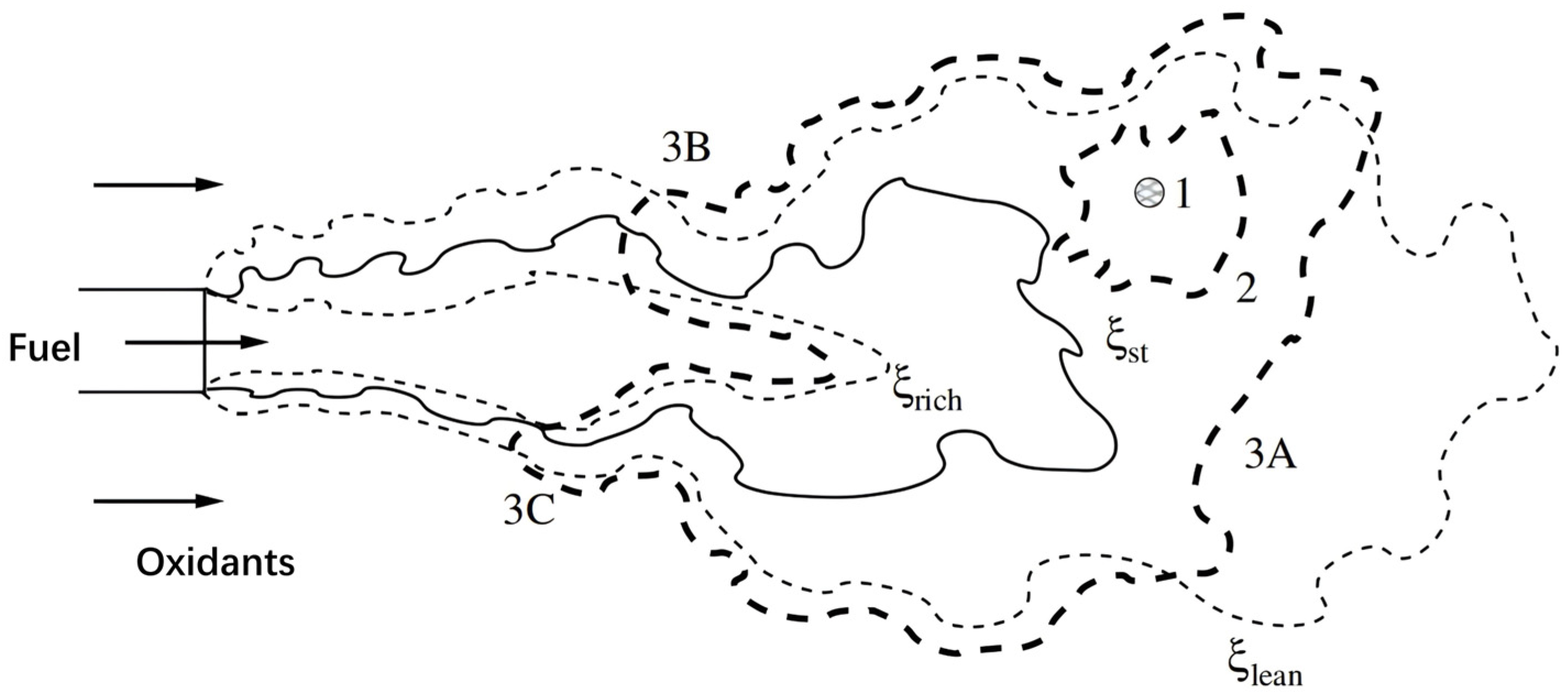
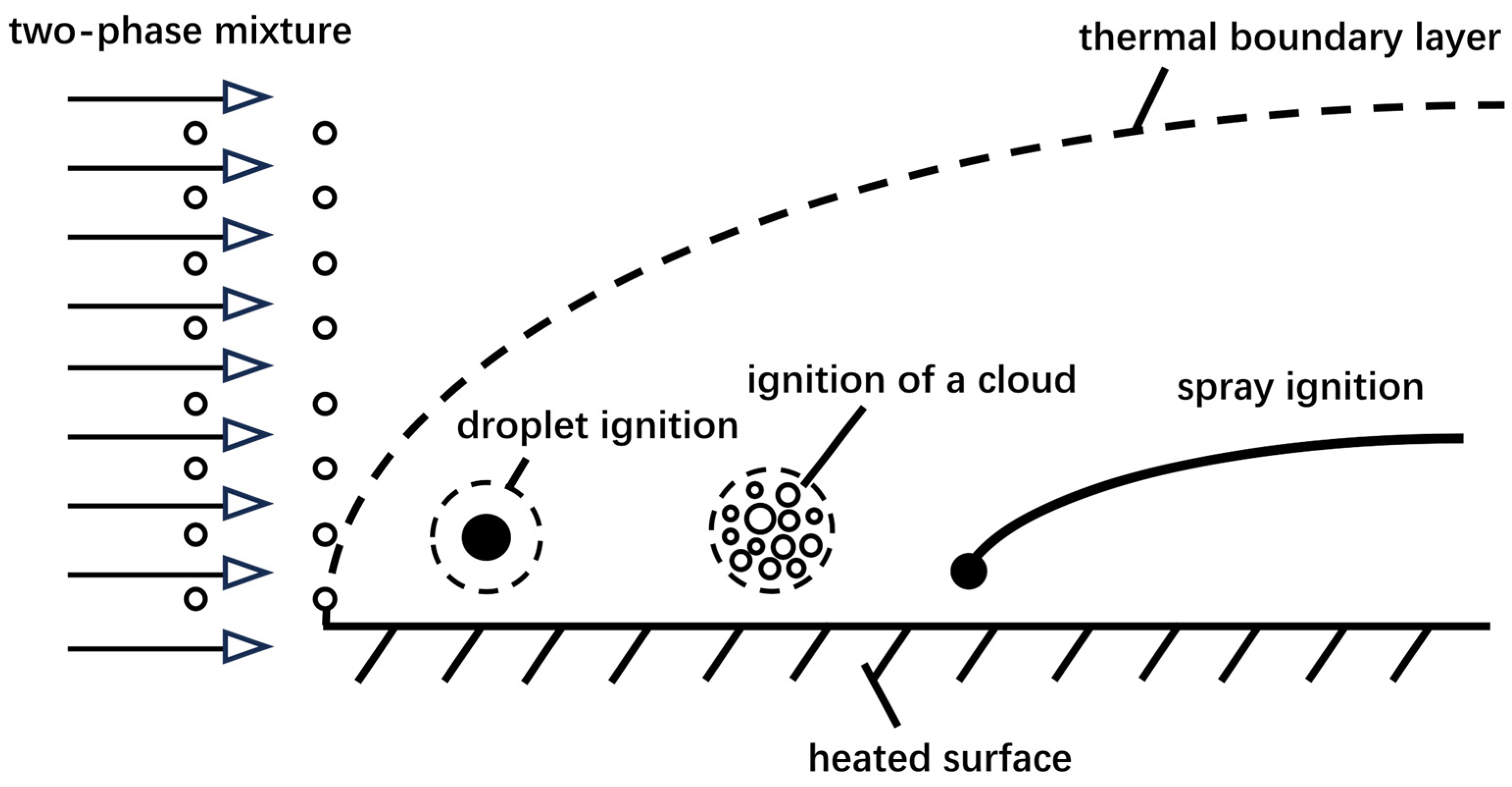
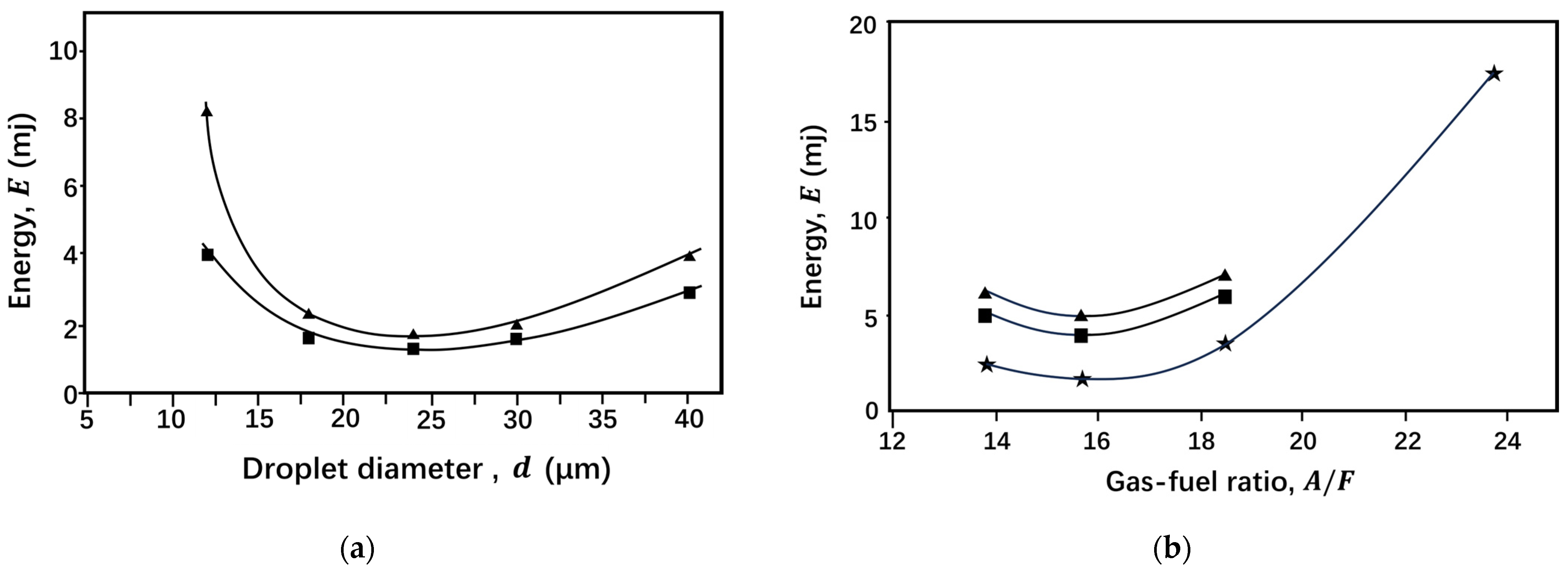

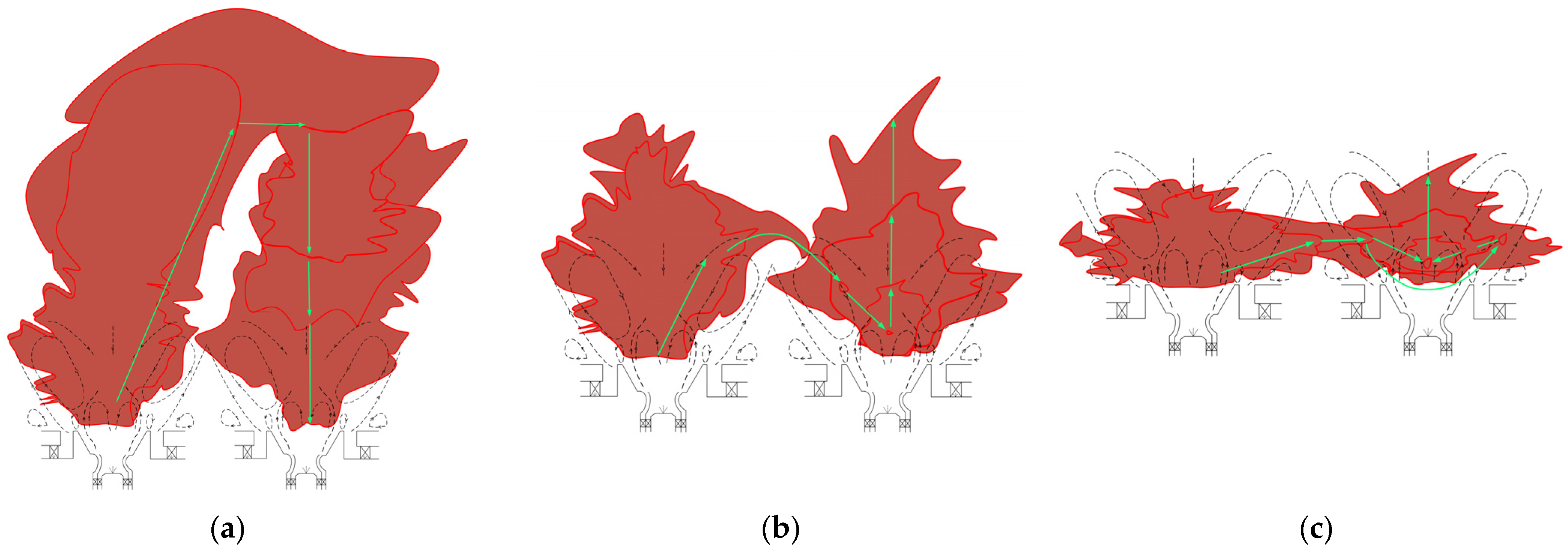
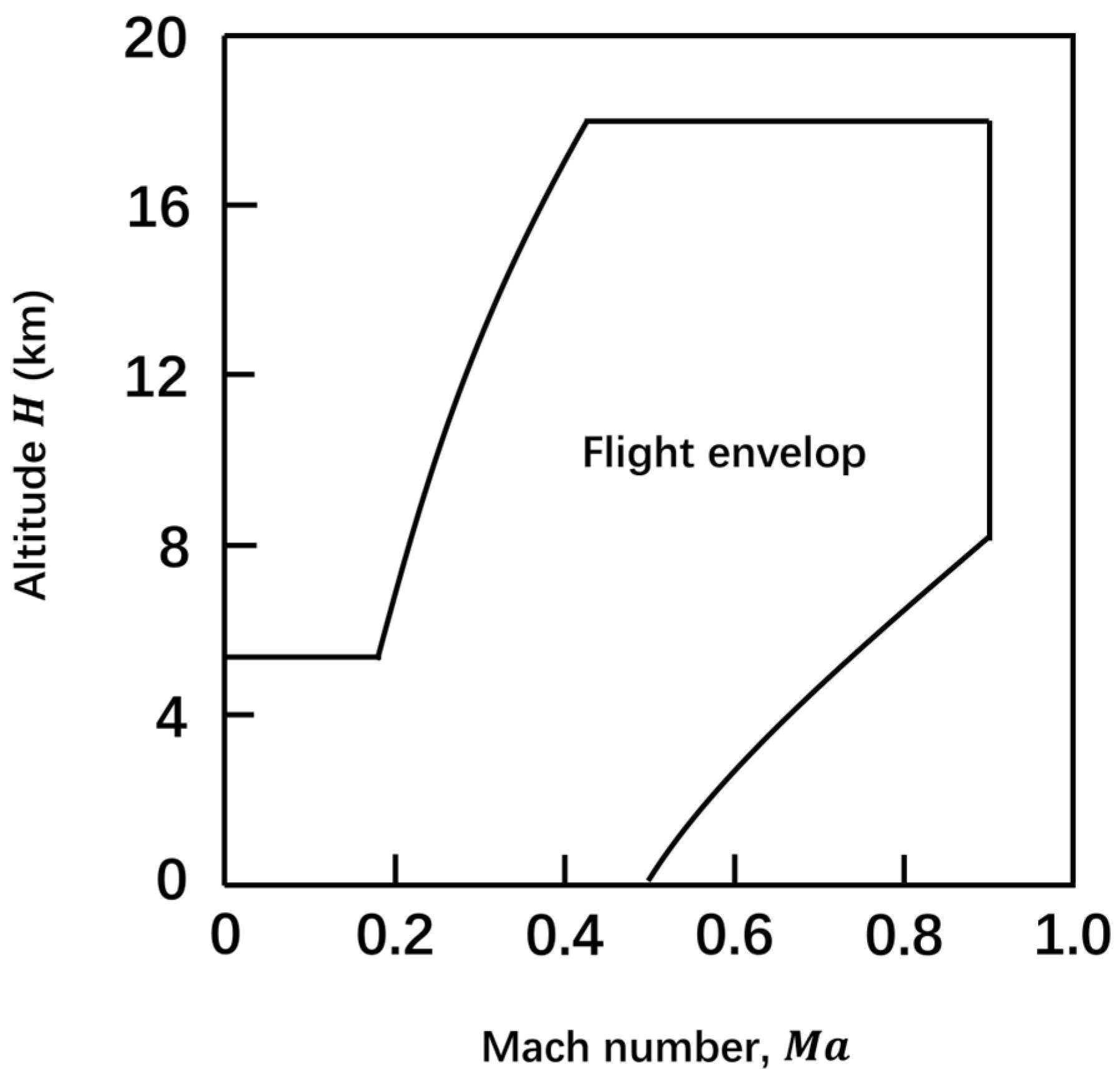

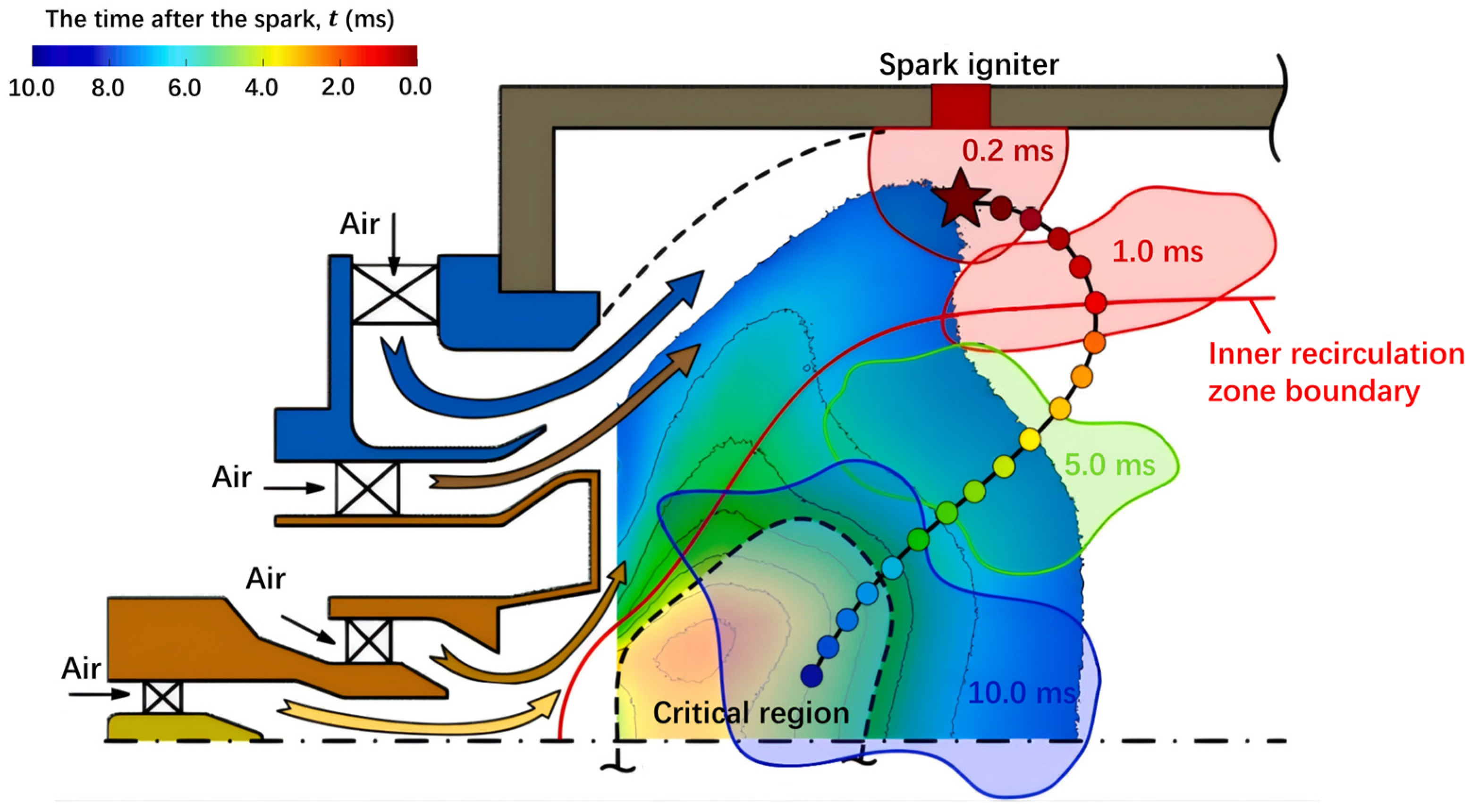

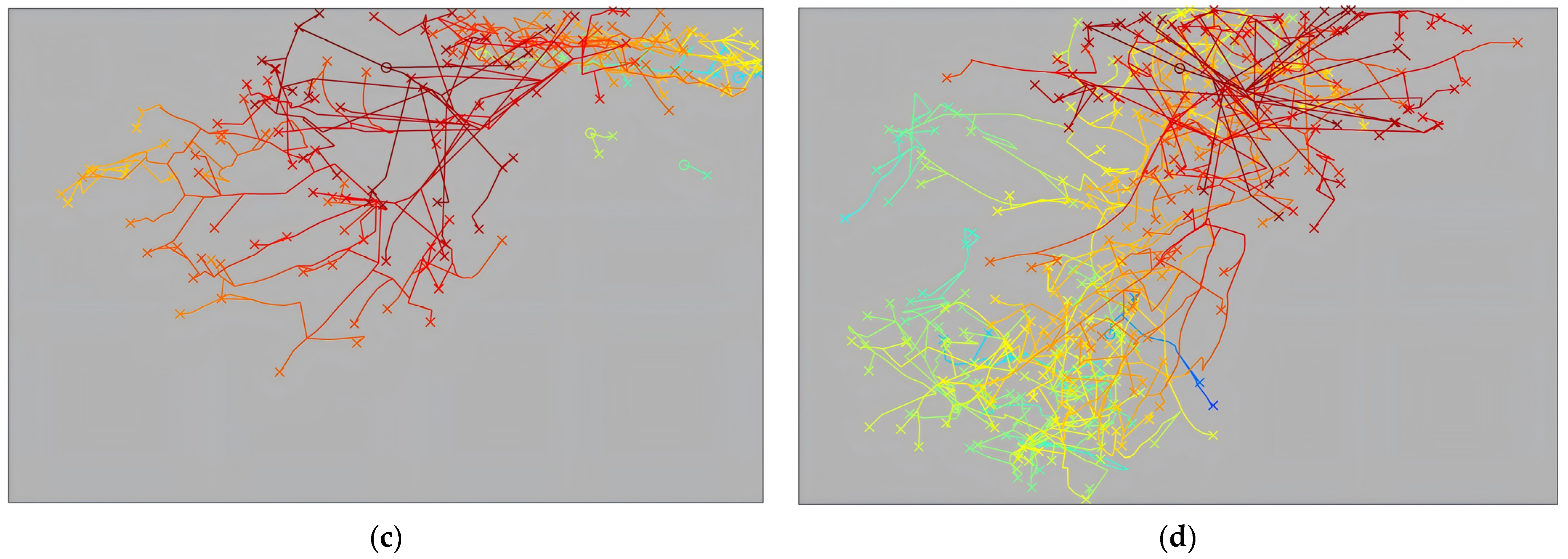



| Test Rig | Pressure Range | Temperature Range |
|---|---|---|
| SCR | Down to 0.2 bar [18] | 243 K or less [18] |
| MERCATO | 0.5 to 1 bar [66] | 233 K to 473 K [66] |
| HARTF | Down to 0.276 bar [65] | Down to 227 K [65] |
| ISCAR | Down to 0.4 bar [54] | Down to 253 K [54] |
| IET | Down to 0.1 bar | Down to 213 K |
Disclaimer/Publisher’s Note: The statements, opinions and data contained in all publications are solely those of the individual author(s) and contributor(s) and not of MDPI and/or the editor(s). MDPI and/or the editor(s) disclaim responsibility for any injury to people or property resulting from any ideas, methods, instructions or products referred to in the content. |
© 2025 by the authors. Licensee MDPI, Basel, Switzerland. This article is an open access article distributed under the terms and conditions of the Creative Commons Attribution (CC BY) license (https://creativecommons.org/licenses/by/4.0/).
Share and Cite
Zhu, Y.; Wang, S.; Wang, K.; Liu, Y.; Liu, C.; Liu, F.; Yang, J.; Mu, Y.; Xu, G. A Review of Ignition Characteristics and Prediction Model of Combustor Under High-Altitude Conditions. Energies 2025, 18, 527. https://doi.org/10.3390/en18030527
Zhu Y, Wang S, Wang K, Liu Y, Liu C, Liu F, Yang J, Mu Y, Xu G. A Review of Ignition Characteristics and Prediction Model of Combustor Under High-Altitude Conditions. Energies. 2025; 18(3):527. https://doi.org/10.3390/en18030527
Chicago/Turabian StyleZhu, Yuhui, Shaolin Wang, Kaixing Wang, Yushuai Liu, Cunxi Liu, Fuqiang Liu, Jinhu Yang, Yong Mu, and Gang Xu. 2025. "A Review of Ignition Characteristics and Prediction Model of Combustor Under High-Altitude Conditions" Energies 18, no. 3: 527. https://doi.org/10.3390/en18030527
APA StyleZhu, Y., Wang, S., Wang, K., Liu, Y., Liu, C., Liu, F., Yang, J., Mu, Y., & Xu, G. (2025). A Review of Ignition Characteristics and Prediction Model of Combustor Under High-Altitude Conditions. Energies, 18(3), 527. https://doi.org/10.3390/en18030527







